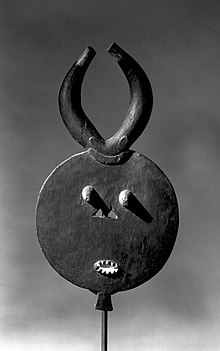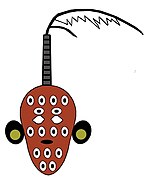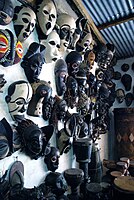
Odinani, also known as Odinala, Omenala, Odinana, and Omenana, is the traditional cultural belief and practice of the Igbo people of south east Nigeria. These terms, as used here in the Igbo language, are synonymous with the traditional Igbo "religious system" which was not considered separate from the social norms of ancient or traditional Igbo societies. Theocratic in nature, spirituality played a huge role in their everyday lives. Although it has largely been synchronized with Catholicism, the indigenous belief system remains in strong effect among the rural, village and diaspora populations of the Igbo. Odinani can be found in Haitian Voodoo, Obeah, Santeria and even Candomblé. Odinani is a pantheistic and polytheistic faith, having a strong central deity at its head. All things spring from this deity. Although a pantheon of other gods and spirits, these being Ala, Amadiọha, Anyanwụ, Ekwensu, Ikenga, exists in the belief system, as it does in many other Traditional African religions, the lesser deities prevalent in Odinani serve as helpers or elements of Chukwu, the central deity.

A mask is an object normally worn on the face, typically for protection, disguise, performance, or entertainment, and often employed for rituals and rites. Masks have been used since antiquity for both ceremonial and practical purposes, as well as in the performing arts and for entertainment. They are usually worn on the face, although they may also be positioned for effect elsewhere on the wearer's body.

The Dogon are an ethnic group indigenous to the central plateau region of Mali, in West Africa, south of the Niger bend, near the city of Bandiagara, and in Burkina Faso. The population numbers between 400,000 and 800,000. They speak the Dogon languages, which are considered to constitute an independent branch of the Niger–Congo language family, meaning that they are not closely related to any other languages.

African art describes the modern and historical paintings, sculptures, installations, and other visual culture from native or indigenous Africans and the African continent. The definition may also include the art of the African diasporas, such as: African-American, Caribbean or art in South American societies inspired by African traditions. Despite this diversity, there are unifying artistic themes present when considering the totality of the visual culture from the continent of Africa.

The Igala people are an ethnic group native to the region south of the confluence of the Niger and Benue Rivers in central Nigeria. The Igala people are located in an ecologically diverse region of Nigeria, ideal for the cultivation of crops, and have been influenced culturally by many surrounding cultures.
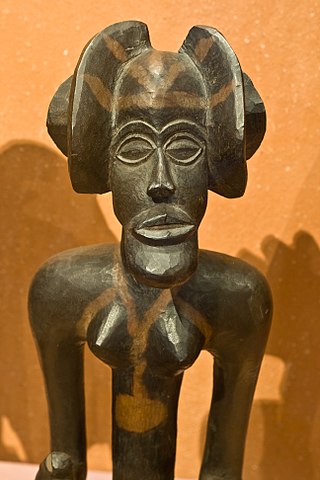
The Chokwe people, known by many other names, are a Bantu ethnic group of Central and Southern Africa. They are found primarily in Angola, southwestern parts of the Democratic Republic of the Congo, and northwestern parts of Zambia.

Most African sculpture was historically in wood and other organic materials that have not survived from earlier than at most a few centuries ago; older pottery figures are found from a number of areas. Masks are important elements in the art of many peoples, along with human figures, often highly stylized. There is a vast variety of styles, often varying within the same context of origin depending on the use of the object, but wide regional trends are apparent; sculpture is most common among "groups of settled cultivators in the areas drained by the Niger and Congo rivers" in West Africa. Direct images of African deities are relatively infrequent, but masks in particular are or were often made for traditional African religious ceremonies; today many are made for tourists as "airport art". African masks were an influence on European Modernist art, which was inspired by their lack of concern for naturalistic depiction.

A masquerade ceremony is a cultural or religious event involving the wearing of masks. The practice has been seen throughout history from the prehistoric era to present day. They have a variety of themes. Their meanings can range from anything including life, death, and fertility. In the Dogon religion, the traditional beliefs of the Dogon people of Mali, there are several mask dances, including the Sigi festival. The Sigi entered the Guinness Book of Records as the "Longest religious ceremony".
The Bwa is an African society that is native to Burkina Faso. This society has an approximate population of over 300,000 persons. The Bwa people live in a number of individualized communities. They have no central government, and rely on their community standards. They are most known for their scarification and elaborate plank masks.

Igbo art is any piece of visual art originating from the Igbo people. The Igbo produce a wide variety of art including traditional figures, masks, artifacts and textiles, plus works in metals such as bronze. Artworks from the Igbo have been found from as early as 9th century with the bronze artifacts found at Igbo Ukwu. With processes of colonialism and the opening of Nigeria to Western influences, the vocabulary of fine art and art history came to interact with established traditions. Therefore, the term can also refer to contemporary works of art produced in response to global demands and interactions.
The Songye people, sometimes written Songe, are a Bantu ethnic group from the central Democratic Republic of the Congo. They speak the Songe language. They inhabit a vast territory between the Sankuru/Lulibash river in the west and the Lualaba River in the east. Many Songye villages can be found in present-day East Kasai province, parts of Katanga and Kivu Province. The people of Songye are divided into thirty-four conglomerate societies; each society is led by a single chief with a Judiciary Council of elders and nobles (bilolo). Smaller kingdoms east of the Lomami River refer to themselves as Songye, other kingdoms in the west, refer to themselves as Kalebwe, Eki, Ilande, Bala, Chofwe, Sanga and Tempa. As a society, the people of Songye are mainly known as a farming community; they do, however, take part in hunting and trading with other neighboring communities.
Igbo culture are the customs, practices and traditions of the Igbo people of southeastern Nigeria. It consists of ancient practices as well as new concepts added into the Igbo culture either by cultural evolution or by outside influence. These customs and traditions include the Igbo people's visual art, music and dance forms, as well as their attire, cuisine and language dialects. Because of their various subgroups, the variety of their culture is heightened further.

Nyau is a secret society of the Chewa, an ethnic group of the Bantu peoples from Central and Southern Africa. The Nyau society consists of initiated members of the Chewa people, forming the cosmology or indigenous religion of the people. Initiations are separate for men and for women, with different knowledge learned and with different ritual roles in the society according to gender and seniority. Only initiates are considered to be mature and members of the Nyau.

An Epa mask is a ceremonial mask worn by the Yoruba people of Nigeria during the Epa masquerade. Carvings representing priests, hunters, farmers, kings, and mothers are usually depicted on the masks. They are used to acknowledge important roles within the community, and to honor those who perform the roles, as well as ancestors who performed those roles in the past.

The Sandobele are members of the Sandogo, an authoritative women's society of the Senufo people, who practice divination. The Senufo inhabit the savannas and tropical rain forests of northern Côte d'Ivoire and the nearby land in Mali and Burkina Faso. The Sandogo is responsible for sustaining positive relationships with the spirit world through divination and for protecting the purity of each kinship group. The word Sandobele originates from the Senufo language.

Public masquerades play an extremely significant role in the life of the Mende people - one of the two largest ethnic groups in Sierra Leone.

The art of Burkina Faso is the product of a rich cultural history. In part, this is because so few people from Burkina have become Muslim or Christian. Many of the ancient artistic traditions for which Africa is so well known have been preserved in Burkina Faso because so many people continue to honor the ancestral spirits, and the spirits of nature. In great part they honor the spirits through the use of masks and carved figures. Many of the countries to the north of Burkina Faso had become predominantly Muslim, while many of the countries to the south of Burkina Faso are heavily Christian. In contrast many of the people of Burkina Faso continue to offer prayers and sacrifices to the spirits of nature and to the spirits of their ancestors. The result is that they continue to use the sorts of art that we see in museums in Europe and America.
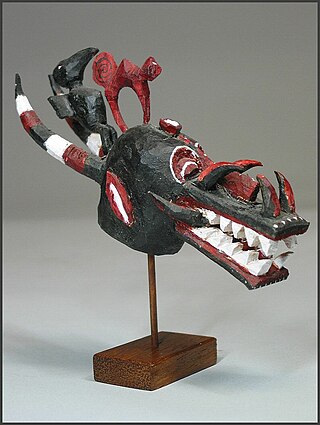
The kponyungo is a ritual mask created by the Senufo people, an ethnolinguistic group residing in Africa's Ivory Coast.

The Binou is a Dogon totemic, religious order and secret ceremonial practice which venerates the immortal ancestors. It can also mean a water serpent or protector of a family or clan in Dogon. It is one of the four tenets of Dogon religion—an African spirituality among the Dogon people of Mali. Although the Dogons' "Society of the Masks" is more well known, due in part to Dogon mask–dance culture which attracts huge tourism, it is only one aspect of Dogon religion, which apart from the worship of the Creator God Amma, a rather distant and abstract deity in the Dogon world-view, is above all made up of ancestor veneration. The Binou serves as one of the four aspects of Dogon religion's ancestor veneration. Other than the Binou and the worship of Amma, the other three aspects of the religion includes the veneration of Lebe, which pertains to an immortal ancestor (Lebe) who suffered a temporary death in Dogon primordial time but was resurrected by the Nommo; the veneration of souls; and lastly, the Society of the Masks, which relates to dead ancestors in general. These myths are in oral form—known to us in a secret language. They form the framework of Dogon's religious knowledge, and are the fixed Dogon's sources relating to the creation of the universe; the invention of fire, speech and culture.

Awa, also known as the Awa Society, the Society of Masks, is an African mask and initiatory society of the Dogon people of Mali which is made up of circumcised men, and whose role is both ritual and political within Dogon society. The Awa Society takes an important role in Dogon religious affairs, and regularly preside over funereally rites and the dama ceremony—a ritual ceremony that marks the end of bereavement in Dogon country. This Society is one of the important aspect of Dogon religious life—which is primarily based on the worship of the single omnipotent, omniscient and omnipresent Creator God Amma and the veneration of the ancestors. Although it is only one aspect of Dogon's religious sects, it is perhaps more well known than the others partly due to Dogon mask–dance culture which attracts huge tourism, and their masks highly sought after, and in fact, one of the first to be sought after by art collectors in the west.


